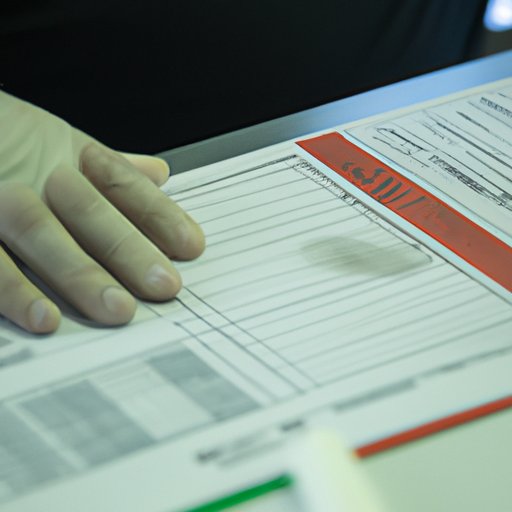I. Introduction
Fingerprinting is a process that involves recording fingerprints for identification purposes. It is used for a variety of reasons, including employment and background checks, security clearances, adoption and immigration procedures, and more. If you have ever been fingerprinted or need to be fingerprinted in the future, you may wonder how long it takes to get fingerprints. In this article, we will explore the fingerprinting process, factors impacting processing time, and tips for preparing for fingerprinting to avoid potential delays.
II. The Fingerprinting Process and Factors Impacting Processing Time
The fingerprinting process involves collecting fingerprints using one of two methods: ink and paper fingerprinting or digital fingerprinting. Ink and paper fingerprinting involves pressing inked fingers onto a paper card to record the fingerprints. Digital fingerprinting, on the other hand, involves using an electronic fingerprint scanner to create a digital image of the fingerprints.
A variety of factors can impact the processing time for fingerprints, including backlogs of requests and errors in the submission. Delays can also occur if the fingerprints are not of sufficient quality or if there are issues with the identification being used.
III. Average Fingerprint Processing Time for Different Types of Background Checks
Processing times for fingerprints can vary depending on the type of background check being performed. The average processing time for employment background checks is typically 24-48 hours, while security clearance background checks can take up to 30 days or longer. Immigration and adoption background checks can also take several weeks or longer to complete.
Processing times may differ based on the type of background check requested due to the level of scrutiny required and the depth of the investigation being conducted.
IV. Differences in Fingerprinting Timelines Based on the Method of Collection
The processing time for fingerprints can also differ depending on the method of collection used. Ink and paper fingerprinting typically takes longer to process than digital fingerprinting due to the manual processing involved. Digital fingerprinting, on the other hand, can be processed much more quickly due to the ability to transmit the fingerprints digitally.
Additionally, digital fingerprints are less likely to be rejected due to quality issues, which can further reduce processing time.
V. Public versus Private Fingerprinting Services and Processing Times
There may also be a difference in processing times between public and private fingerprinting services. Public services, such as those provided by local law enforcement agencies, may have longer wait times and processing times due to high demand and limited resources. Private services, on the other hand, may offer faster processing times due to the ability to prioritize requests and allocate resources accordingly.
However, it is important to note that private services may come with higher fees than public services.
VI. Tips on How to Prepare for Fingerprinting to Avoid Potential Delays
Proper preparation for fingerprinting can help to ensure a smoother and quicker process. This includes bringing proper identification, ensuring that fingertips are clean and dry, and avoiding lotion or other substances that could interfere with the fingerprinting process.
It may also be helpful to inquire about potential wait times and processing times prior to scheduling an appointment to ensure that the process can be completed within a reasonable timeframe.
VII. Real-Life Examples and Success Stories
Real-life examples of successful fingerprinting and timely processing can provide insight into the fingerprinting process and potential outcomes. For example, individuals who have successfully completed the fingerprinting process within an expedited timeframe may offer valuable tips and advice for others going through the process.
Additionally, success stories of individuals who were able to resolve any delays or issues during the fingerprinting process can provide valuable information on how to navigate potential obstacles.
VIII. What to Do if Fingerprints are Rejected
If fingerprints are rejected, it may be necessary to repeat the fingerprinting process. However, there are steps that can be taken to potentially reduce processing time during a repeat fingerprinting process. This includes properly preparing for the process, using higher quality identification, and verifying that the fingerprinting equipment is functioning properly.
IX. Conclusion
In conclusion, the processing time for fingerprints can vary depending on a variety of factors, including the type of background check being conducted, the method of fingerprinting used, and the type of service being utilized. It is important to properly prepare for fingerprinting to avoid potential delays, and to understand that repeat fingerprinting may be required if initial fingerprints are rejected.
By following the tips and information provided in this article, individuals can help to ensure a smoother and quicker fingerprinting process.
(Note: Is this article not meeting your expectations? Do you have knowledge or insights to share? Unlock new opportunities and expand your reach by joining our authors team. Click Registration to join us and share your expertise with our readers.)
